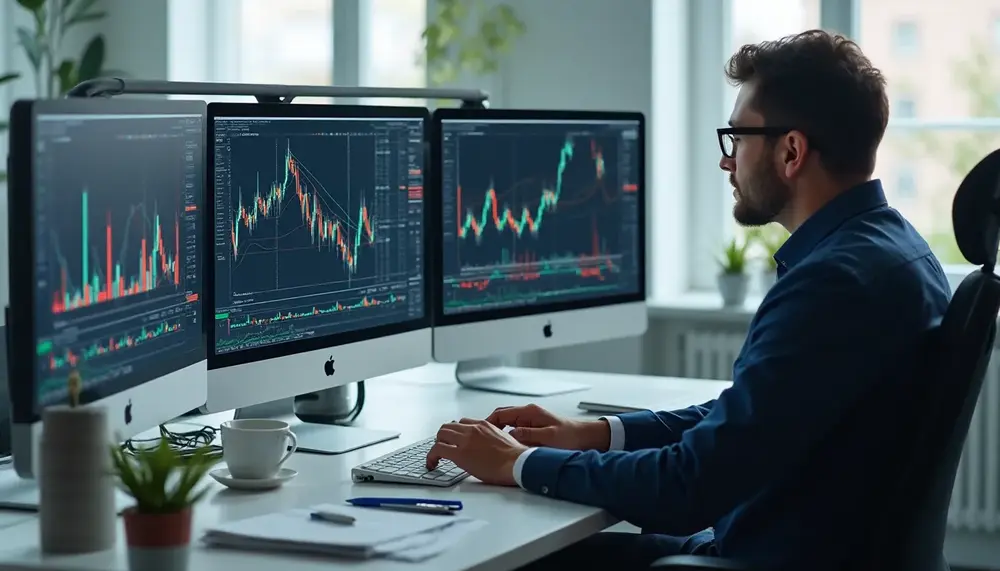Table of Contents:
Decoding Trading Systems: Exact Definitions That Matter
Decoding Trading Systems: Exact Definitions That Matter
Let’s get straight to the heart of what separates a true trading system from mere guesswork. A trading system is not just a collection of rules scribbled on a napkin or a hunch dressed up as a plan. It’s a rigorously defined, repeatable process that transforms raw market data into actionable buy or sell decisions—every single time, no matter what mood you’re in or how wild the headlines get.
What makes a trading system truly matter? It’s the clarity and precision of its components:
- Rule-Based Logic: Every decision, from entry to exit, is governed by explicit, testable rules. There’s no room for “I feel like it” or “maybe today.”
- Market Adaptation: A system is tailored to specific market environments—what works in volatile crypto markets may fail miserably in slow-moving bonds. That’s why exact definitions are non-negotiable.
- Objective Signal Generation: The system relies on quantifiable signals, not gut instinct. These signals are derived from price, volume, volatility, or other measurable factors.
- Consistency and Auditability: Every trade can be traced back to a defined rule. This makes performance review and improvement possible, and honestly, it’s the only way to know if your edge is real or just a lucky streak.
Without this level of definition, you’re not trading—you’re gambling. The real breakthrough comes when you realize that a well-defined system is your only shot at sustainable, scalable results. If you can’t write it down so that someone else could follow it without calling you for clarification, it’s not a system. It’s noise.
Inside the Exchange: How Modern Trading Mechanics Work
Inside the Exchange: How Modern Trading Mechanics Work
Modern exchanges are not the chaotic pits of the past. Instead, they’re highly automated, algorithm-driven environments where speed and precision rule. Orders from around the globe zip in, get matched, and are executed in milliseconds—sometimes even faster. But what’s really happening under the hood?
- Order Matching Engines: At the core, exchanges use advanced matching engines. These digital systems continuously pair buy and sell orders based on price and time priority. The highest bid meets the lowest ask, and a trade is born—no human handshakes required.
- Order Types and Instructions: Traders can submit a range of order types—market, limit, stop, and more. Each comes with its own set of instructions, allowing for precise control over how and when trades execute. For example, a limit order ensures you never pay more (or sell for less) than your specified price.
- Pre- and Post-Trade Transparency: Exchanges provide real-time data on order books, recent trades, and price movements. This transparency lets participants see liquidity and gauge market sentiment, but also means that every move is visible to competitors.
- Role of Market Makers: To keep things flowing, designated market makers stand ready to buy or sell at quoted prices. Their job? Provide liquidity and help prevent wild price swings, especially in less active markets.
- Continuous Auction Process: Unlike the old open-outcry sessions, most modern exchanges run continuous auctions. Orders are matched as they arrive, ensuring prices reflect the latest supply and demand dynamics—tick by tick, second by second.
So, the modern exchange is a blend of relentless automation, transparency, and strategic human oversight. Understanding these mechanics is not just academic—it’s the key to timing, execution, and ultimately, trading success.
Step-by-Step Creation of a Rule-Based Trading System
Step-by-Step Creation of a Rule-Based Trading System
Building a rule-based trading system is like assembling a custom engine: every component must fit and function in harmony. Here’s a clear, no-nonsense roadmap for designing a system that’s both robust and practical—no shortcuts, no guesswork.
-
1. Define Your Market Universe
Select the specific assets or markets you want to trade. Are you focusing on large-cap stocks, forex pairs, or maybe a handful of commodities? Narrowing your universe avoids unnecessary noise and lets you tailor your system for optimal performance. -
2. Formulate a Hypothesis
Identify a repeatable pattern or market behavior you believe offers an edge. Maybe you notice certain stocks tend to rally after earnings beats, or perhaps volatility spikes signal reversals. Your hypothesis should be testable and rooted in observable data. -
3. Select Quantitative Indicators
Choose measurable variables—like moving averages, RSI, or volume surges—that will generate your entry and exit signals. Avoid piling on too many; simplicity often trumps complexity. -
4. Write Explicit Entry and Exit Rules
Spell out the exact conditions for entering and exiting trades. For example: “Buy when the 20-day moving average crosses above the 50-day.” Ambiguity is your enemy here. -
5. Set Risk Management Parameters
Define your position sizing, stop-loss levels, and maximum exposure. This is where you protect your capital and ensure that no single trade can sink your ship. -
6. Backtest with Historical Data
Run your rules on past market data to evaluate performance. Look for consistency, not just a lucky streak. Pay attention to drawdowns, win rates, and risk-adjusted returns. -
7. Forward Test in Real Time
Before committing real money, test your system in a live environment using a demo account or small positions. This step exposes flaws that backtesting can’t reveal. -
8. Refine and Monitor
Tweak your rules based on observed performance, but resist the urge to over-optimize. Markets evolve, so ongoing monitoring and occasional adjustments are essential for long-term viability.
By following these steps, you create a system that’s not just theoretical, but battle-tested and ready for real-world action. That’s how you move from wishful thinking to disciplined, data-driven trading.
Technical Indicators in Action: Signals, Strengths, and Pitfalls
Technical Indicators in Action: Signals, Strengths, and Pitfalls
Technical indicators are the workhorses of systematic trading, but their real-world application is a balancing act between insight and illusion. When used thoughtfully, they transform raw price data into actionable signals. Yet, even the most popular indicators—think RSI, MACD, or Bollinger Bands—can mislead if you don’t understand their quirks.
-
Signal Generation in Practice
Indicators translate complex market movements into clear entry or exit cues. For example, a sudden spike in the Relative Strength Index (RSI) might suggest an overbought condition, hinting at a potential reversal. However, the same reading in a strong trend could mean the asset is simply gaining momentum, not ready to turn. -
Strengths: Objectivity and Speed
The main appeal? Indicators cut through noise and provide fast, repeatable signals. They allow traders to react swiftly, without second-guessing every tick. In fast-moving markets, this objectivity is pure gold. -
Pitfalls: False Signals and Overfitting
No indicator is infallible. Markets are messy, and indicators can generate false positives—signals that look promising but fizzle out. Over-optimizing settings to fit past data (curve fitting) is another trap, often leading to poor performance when real money is on the line. -
Context Matters
Indicators don’t exist in a vacuum. Their effectiveness can swing wildly depending on market regime—what works in a trending market may fail in a choppy one. Blind reliance is risky; always consider the broader context. -
Combining Indicators
Layering multiple indicators can filter out noise, but too many can create analysis paralysis. The sweet spot? A small, complementary set that covers different aspects—momentum, volatility, and trend.
In short, technical indicators are powerful tools, but they demand respect and skepticism. Mastering their signals means knowing when to trust them—and when to step back and let the market breathe.
A Real-Life Walkthrough: Applying a Trading System in Today’s Market
A Real-Life Walkthrough: Applying a Trading System in Today’s Market
Imagine you’re trading the S&P 500 on a volatile Monday morning. Your system, built for short-term momentum, is ready to be put to the test. Here’s how it unfolds in real time:
-
Pre-market Preparation
You scan for overnight news and economic releases, noting any surprises that could trigger unusual volatility. Your system requires a minimum volume threshold at the open, so you watch the first few minutes for confirmation. -
Signal Detection
As the market opens, your algorithm identifies a breakout above the previous day’s high. The trigger: a surge in volume and a sharp uptick in price within the first 15 minutes. The system flags a long entry, and you execute without hesitation. -
Order Execution
You place a limit order, as your rules dictate, ensuring you don’t chase the price. Within seconds, the order fills. You immediately set a stop-loss and a profit target, both calculated based on current volatility. -
Active Monitoring
The trade develops. The system monitors for adverse moves—if volatility spikes beyond your predefined range, it automatically tightens the stop. If price momentum continues, your trailing stop locks in gains as the market moves in your favor. -
Exit and Review
The price hits your profit target. The system closes the position, logs the trade, and updates your performance dashboard. You review the trade: Did the entry match your rules? Was the exit optimal? Any slippage or execution delays? You jot down notes for future tweaks.
This hands-on process is dynamic, requiring you to trust your system but also stay alert for outliers—like sudden news shocks or liquidity gaps. The key takeaway: applying a trading system in today’s market is about disciplined execution, real-time adaptation, and relentless review. That’s how theory turns into actual results.
Understanding Market Participants and Their Roles
Understanding Market Participants and Their Roles
Every market is a living ecosystem, shaped by the diverse motives and behaviors of its participants. Knowing who’s at the table—and what drives them—can be the difference between reading the market’s true pulse and getting blindsided by unexpected moves.
-
Institutional Investors
These are the heavyweights: pension funds, mutual funds, insurance companies, and hedge funds. Their trades often move markets, but their goals are typically long-term growth or risk management. They rely on deep research, sophisticated models, and sometimes, sheer size to influence price trends. -
Retail Traders
Individual investors, trading from home or via mobile apps, bring agility and unpredictability. While they lack the resources of institutions, their collective action—especially during viral market events—can trigger sharp, short-term price swings. -
Market Makers
These specialized firms stand ready to buy or sell at publicly quoted prices, providing essential liquidity. By narrowing bid-ask spreads, they keep markets efficient and tradable, even in less popular securities. -
High-Frequency Traders (HFTs)
Using advanced algorithms and lightning-fast connections, HFTs exploit tiny price discrepancies across markets. Their presence boosts liquidity but can also amplify volatility, especially during periods of market stress. -
Proprietary Trading Firms
These companies trade with their own capital, seeking short-term profits through strategies ranging from arbitrage to statistical modeling. Their flexibility and risk appetite often make them early movers on new opportunities. -
Regulators and Exchanges
Not traders in the classic sense, but crucial to the market’s structure. Regulators enforce fair play and transparency, while exchanges set the rules of engagement and ensure smooth operation.
Each participant brings unique incentives and tactics. Understanding these roles helps you anticipate market moves, spot hidden risks, and align your strategy with the real forces at work beneath the surface.
Recognizing and Navigating Market Structure Variations
Recognizing and Navigating Market Structure Variations
Market structure isn’t a one-size-fits-all concept—it shifts across regions, asset classes, and even within the same exchange over time. Recognizing these differences is crucial for anyone aiming to execute trades efficiently and avoid hidden pitfalls.
-
Order-Driven vs. Quote-Driven Markets
In order-driven markets, prices are determined by matching buy and sell orders directly. In quote-driven systems, market makers set bid and ask prices, standing ready to transact. Each structure impacts liquidity, transparency, and execution speed in its own way. -
Centralized vs. Fragmented Venues
Some assets trade on a single, centralized exchange, while others are spread across multiple venues. Fragmentation can lead to price discrepancies and requires smart order routing to achieve best execution. -
Continuous vs. Auction-Based Trading
Continuous trading allows for real-time transactions throughout the session. Auction-based systems batch orders at set times, often leading to concentrated liquidity and potential price jumps during those windows. -
Hidden Liquidity and Dark Pools
Not all trading happens in plain sight. Dark pools and hidden orders can mask true supply and demand, affecting price discovery and making it trickier to gauge real market depth. -
Regulatory Nuances
Rules around transparency, order types, and trading hours vary globally. These differences can influence strategy selection and risk management, especially for cross-border traders.
Understanding these structural variations isn’t just academic—it directly impacts how you route orders, manage slippage, and adapt your strategy to the unique rhythm of each market environment.
Translating Systematic Knowledge into Trading Success
Translating Systematic Knowledge into Trading Success
Turning systematic knowledge into actual trading success demands more than just understanding theory—it’s about execution, adaptation, and relentless self-assessment. The leap from knowing to doing is where most traders stumble, but it’s also where the real edge lies.
-
Bridging the Gap with Discipline
Consistently applying your system, even when emotions run high or the market throws curveballs, is non-negotiable. Automated alerts, pre-defined checklists, and trading journals help enforce discipline and reduce costly lapses in judgment. -
Data-Driven Feedback Loops
Systematic traders thrive on feedback. After each trade, analyze outcomes with a critical eye—did the system perform as expected, or did market conditions expose a blind spot? Use this data to refine parameters, but resist the urge to tweak endlessly. -
Adapting to Market Evolution
Markets are living, breathing entities. What works today may not work tomorrow. Schedule regular reviews of your system’s performance, and be ready to pivot if persistent patterns of underperformance emerge. -
Leveraging Technology
Advanced analytics, real-time data feeds, and robust backtesting platforms are not just nice-to-haves—they’re essential for identifying subtle shifts in market dynamics and maintaining your edge. -
Building Psychological Resilience
Even the best systems endure drawdowns. Developing mental resilience—through mindfulness, routine, or peer support—prevents panic-driven decisions and keeps you aligned with your strategy during rough patches.
In essence, systematic knowledge becomes trading success when it’s combined with discipline, continuous feedback, adaptability, and emotional fortitude. This holistic approach transforms abstract strategies into consistent, real-world results.
Conclusion: Leveraging Systematic Insight for Competitive Edge
Conclusion: Leveraging Systematic Insight for Competitive Edge
Achieving a true competitive edge in trading today requires more than technical know-how or intuition—it hinges on the ability to extract, interpret, and act on systematic insights faster and more effectively than the crowd. This isn’t just about following rules; it’s about cultivating a mindset that prioritizes evidence over ego and adapts in real time to shifting market dynamics.
- Continuous Innovation: The most successful traders invest in ongoing research, integrating fresh data sources and novel analytical methods to uncover new inefficiencies before they become mainstream.
- Collaborative Intelligence: Harnessing the collective wisdom of diverse teams—combining quantitative analysts, programmers, and market veterans—often leads to breakthroughs that solo efforts rarely achieve.
- Ethical and Regulatory Awareness: Staying ahead also means anticipating regulatory shifts and embedding compliance into system design, ensuring strategies remain viable as rules evolve.
- Scenario Planning: Proactively stress-testing systems against rare but plausible market shocks builds resilience and uncovers hidden vulnerabilities that might otherwise go unnoticed.
- Learning from Adjacent Fields: Drawing inspiration from fields like behavioral economics, machine learning, or even game theory can reveal unconventional strategies and risk controls.
Ultimately, leveraging systematic insight isn’t a one-time achievement—it’s a continuous process of learning, collaboration, and adaptation. Those who embrace this approach don’t just survive in competitive markets; they set the pace for everyone else.
Experiences and Opinions
Navigating trading systems can be challenging for many users. A common issue is the overwhelming number of options available. Users often report feeling lost in a sea of information and marketing claims. They seek reliable feedback on various trading systems.
One popular choice is the Trading System Lab (TSL). Many users find it effective for developing trading strategies. A user mentioned, "TSL is now an integral part of my business. It saves time and reduces risk." This sentiment reflects a trend: efficiency is a key factor for successful traders. The ability to deploy systems quickly is crucial, especially in fast-moving markets. TSL reportedly allows users to create systems in a matter of minutes or days, compared to traditional methods that can take weeks.
However, not all experiences are positive. Some users express concerns about the reliance on automated systems. A frequent worry is the loss of personal touch in strategy development. One user admitted, "Letting a machine build the logic felt uncomfortable." This highlights a divide: while some embrace automation, others prefer hands-on control. Trustpilot reviews indicate mixed feelings about this aspect, with a significant portion of users appreciating automated solutions despite initial hesitations source.
Cost Considerations
Cost is another critical factor in users' decisions. Many find that the total expenses associated with systems like TSL are reasonable when compared to hiring additional staff. "For the price of a full-fledged trading seat, I get my own R&D department," stated a user. This perspective suggests that users value cost-effectiveness highly, especially in a competitive market.
On platforms like Forex Factory, users share their strategies and outcomes, providing a wealth of information for those looking to refine their systems. However, not all feedback is universally positive. Some traders mention that certain systems do not align with their trading styles, leading to frustration.
Success Stories and Learning Curves
Success stories abound, particularly with users who adapt their strategies based on the systems they employ. One user shared, "The adaptability of TSL has improved my trading significantly." This highlights the importance of flexibility in trading strategies. Users who are willing to learn and adjust often report better outcomes.
Despite the challenges, many find that engaging with trading systems can lead to significant improvements in their trading performance. Experiences vary widely, but common themes emerge: the need for efficiency, the importance of cost, and the challenge of balancing automation with personal input. As users continue to navigate these systems, sharing their experiences remains essential for community growth.
FAQ: Mastering Trading Systems and Market Mechanics
What exactly is a rule-based trading system?
A rule-based trading system is a set of clearly defined, objective rules that guide every aspect of trade execution—from entry signals to exit criteria and risk management. Unlike intuitive or discretionary trading, a rule-based system ensures consistency, discipline, and repeatability, making it possible to test, audit, and improve strategies over time.
How do modern exchange trading mechanics work?
Modern exchanges utilize computerized matching engines that pair buy and sell orders based on price and time priority. This highly automated process relies on transparent order books, various order types, and, in many markets, market makers who supply liquidity to keep trading smooth and efficient.
Why are technical indicators important in systematic trading?
Technical indicators are essential in systematic trading because they transform raw market data into objective signals. By applying quantifiable metrics, indicators help traders make decisions based on data rather than emotions, enabling swift, repeatable responses to changing market conditions.
What are the key steps in building a robust trading system?
Key steps include defining your market universe, formulating a testable hypothesis, selecting relevant indicators, setting explicit entry and exit rules, establishing risk parameters, backtesting the system with historical data, and then forward testing in real time. Ongoing refinement and monitoring help ensure ongoing effectiveness.
How does understanding market participants and structure provide an edge?
Recognizing who participates in the market—such as institutional investors, retail traders, market makers, and high-frequency traders—and understanding the mechanics of order flow, transparency, and liquidity allows traders to plan more effective entries and exits. This insight helps anticipate market moves, spot risks, and adapt strategies to varying market environments.











